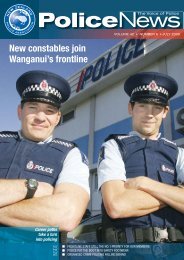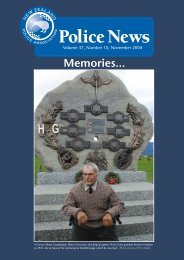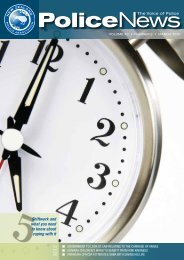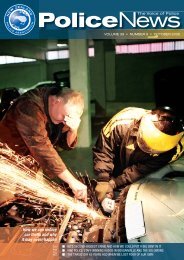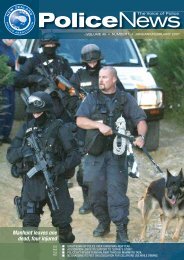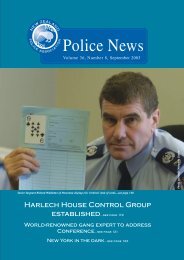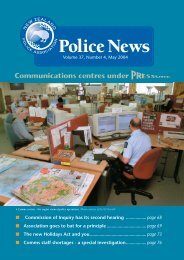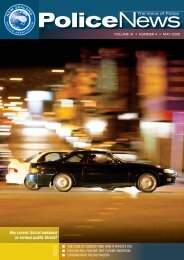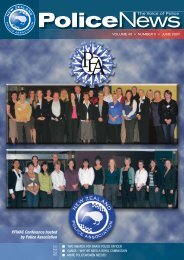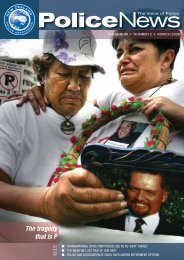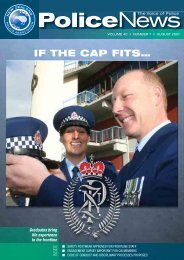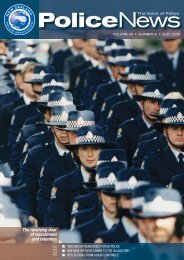banana-skin guide to policing - New Zealand Police Association
banana-skin guide to policing - New Zealand Police Association
banana-skin guide to policing - New Zealand Police Association
Create successful ePaper yourself
Turn your PDF publications into a flip-book with our unique Google optimized e-Paper software.
<strong>New</strong>s/viewsSqueeze on emergency bandwidthMoves in Australia <strong>to</strong> reserve radio spectrum for public safety broadband highlightjust how far <strong>New</strong> <strong>Zealand</strong> is falling behind on the issue.In July, an Australian federal jointparliamentary committee decidedemergency services needed dedicatedbandwidth <strong>to</strong> meet 21st-century emergencyresponse needs. It recommended joiningthe United States, Canada and Britain insetting aside a minimum of 20 MHz inthe 700 MHz band <strong>to</strong> ensure emergencyservices can meet their mobile data needsin the event of a disaster or major incident.Meanwhile, in <strong>New</strong> <strong>Zealand</strong>, the entire700 MHz band – freed up by the switch<strong>to</strong> digital television – will be carvedup in<strong>to</strong> three blocks and auctionedoff by the Government <strong>to</strong> commercialtelecommunications providers before theend of this year.The 700 MHz band (which runs from694-806 MHz) is ideal for fourth-generation(4G) mobile networks that are capable ofcarrying large amounts of data very quickly– up <strong>to</strong> 10 times faster than 3G networks.Telecommunications companies are keen <strong>to</strong>secure slices of the newly available spectrum<strong>to</strong> build these commercially lucrative nextgenerationnetworks.The Government, meanwhile, is eyeing thewindfall gains from the sale, and pointing<strong>to</strong> the economic benefits of widespread 4Gavailability.The trouble is, while there is room in the700 MHz band for <strong>New</strong> <strong>Zealand</strong>’s threemajor telcos, there will be no space left foremergency services.For the same reasons that 4G-capablebandwidth is so desirable <strong>to</strong> telcosworldwide, it is becoming increasinglyimportant <strong>to</strong> police and other emergencyservices.The rollout of iPads and iPhones <strong>to</strong> <strong>New</strong><strong>Zealand</strong> <strong>Police</strong> shows how integral mobiledata is becoming <strong>to</strong> everyday modern<strong>policing</strong>. That data is carried by Vodafoneon its standard network (3G in most places)under a commercial arrangement.However, the benefits of mobilebroadband for emergency responders – notjust police, but also fire, ambulance andcivil defence – are only now beginning <strong>to</strong> berealised. These benefits range from vastlyimproved situational awareness and ta<strong>skin</strong>gco-ordination, through the use of realtimemapping and video imaging, <strong>to</strong> rapiddelivery of operation-specific informationsuch as building blueprints or hazard maps.Mobile broadband has the potential <strong>to</strong> liftthe “fog of war”, by carrying rich information<strong>to</strong> and from the frontline, so both thecommand centres and officers in the fieldknow exactly what they’re dealing with. Inthe real world this could mean better andfaster prioritisation of site responses aftera major earthquake, safer entry in<strong>to</strong> andclearing of affected locations, faster andmore precise establishment of cordons andforward command posts in the right placesat major incidents, and better dynamiccrowd control and security co-ordination atmajor events.Relying on commercial networks <strong>to</strong> carrythis data in an emergency is risky at best. Asthe Australian committee pointed out, “thedesign capacity of commercial networks sitesis limited <strong>to</strong> the expected ‘normal day’ peakloads.As the general public wants <strong>to</strong> know aboutthe status of family, friends and workplacesduring periods of crisis, commercialspectrum and networks experience overloadconditions during such situations.”The benefitsof mobilebroadband foremergencyrespondersare only nowbeginning <strong>to</strong>be realised.Overseas and local events regularlyconfirm this fact. After Welling<strong>to</strong>n’s Julyearthquake, which did minimal damagedespite it being magnitude 6.5, stuff.co.nzreported both Telecom’s mobile network andlandline network were overloaded for 10 <strong>to</strong>20 minutes, nine Vodafone mobile sites wentdown, and five 2degrees mobile sites wereaffected by power outages.Even where forward planning is possible,it may not be enough. During the 2011Rugby World Cup in <strong>New</strong> <strong>Zealand</strong>,additional mobile cell sites were set upjust <strong>to</strong> cope with “normal” demand fromthe huge crowds. If disaster had struck aRWC event, based on overseas experience,even that enhanced network would havebeen flooded by panicked phone calls <strong>to</strong>emergency services, and <strong>to</strong> and from lovedones.The big risk is that police and respondersare hamstrung if those are the samenetworks they rely on <strong>to</strong> share criticalinformation and co-ordinate responses.In the case of a terrorist attack,commercial networks are especiallyunsuitable for emergency responders. In2005, after the London Tube bombings,authorities in <strong>New</strong> York shut down partsof that city’s cellphone network as aprecautionary measure for two weeks <strong>to</strong>prevent any possible triggering of bombsby cellphone. Local cellphone servicescrashed immediately after this year’s Bos<strong>to</strong>nMarathon bombings, with unconfirmedreports claiming this was also donedeliberately <strong>to</strong> prevent further blasts or coordinationbetween the terrorists.Falling back on radio in a major disasteris a 20th-century solution <strong>to</strong> a 21st-centuryproblem. Although digital radio – carriedin the 400 MHZ band – voice calls and“narrowband” data such as texts are useful,their limitations are quickly highlightedeven when trying <strong>to</strong> co-ordinate a rapidlyunfolding business-as-usual <strong>policing</strong>incident such as a fleeing driver, wheremultiple units are involved across severalpolice districts.So why is <strong>New</strong> <strong>Zealand</strong> falling out of stepwith so many of our overseas counterparts?In February this year, the Governmentconfirmed its intention <strong>to</strong> auction the entire700 MHz band <strong>to</strong> commercial networkopera<strong>to</strong>rs for them <strong>to</strong> build new 4Gnetworks. In making its announcement,Communications and InformationTechnology Minister Amy Adams said“Emergency services providers havenow indicated they prefer spectrum inthe 800 MHz band, <strong>to</strong> better align withinternational developments. The exactneeds will be considered at a later date.”That preference appears <strong>to</strong> have beenled by an earlier Australian decision fromthe Australian Communications andMedia Authority, which recommendedsetting aside 10 MHz in the 800 MHzband for public safety broadband. Thatrecommended provision was rejected byemergency services as inadequate, and –perhaps more importantly – unavailable.As is the case in <strong>New</strong> <strong>Zealand</strong>, the 800MHz band in Australia is fully occupiedby telcos and other licence holders.The Australian joint committee’s newrecommendation should be a clear signal forthe <strong>New</strong> <strong>Zealand</strong> Government <strong>to</strong> reconsiderits approach.200 SEPTEMBER 2013POLICE NEWS – THE VOICE OF POLICE



